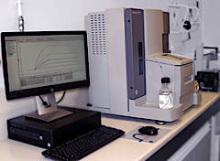Real-time binding data with Biacore™ SPR: from principles to application
Agro-Bio provides a SPR (Surface Plasmon Resonance) affinity analysis services using BiacoreTM technology to deliver real-time, label-free interaction data Our Biacore™ platform gives essential parameters for selecting therapeutic candidates, characterizing antibodies, comparing biosimilars, or demonstrating regulatory compliance with confidence.

Why choose Agro-Bio for your SPR affinity analysis?
- 50 years of experience in immunology and bioanalysis
- In-house Biacore™ platform (T200 & 1K+), operated by expert scientists
- Royalty-free, independent CRO (part of Stago Group)
- Regulatory-ready protocols (EMA / ICH Q6B)
- Custom study design, scientific consulting, and fast turnaround
- Partnering with Agro-Bio gives you access to experts in Biacore™ affinity analysis, combining scientific rigor with regulatory compliance.
Partnering with Agro-Bio gives you scientific rigor with regulatory compliance.
You want to start your Biacore™ affinity analysis project or discuss it?
Contact our expertsWhat is SPR affinity analysis?
Surface Plasmon Resonance (SPR) is a real-time, label-free optical sensing technique used to study binding interactions between two or more molecules. It measures both binding affinity (how tightly two molecules interact) and kinetics (rate at which molecules associate and dissociate), making it ideal for affinity and kinetics analysis.Unlike traditional endpoint assays, SPR provides continuous data from the moment of injection to the end of dissociation, generating a sensorgram that captures both association and dissociation phases. This gives access to the kinetics parameters of the interaction.
Key parameters
| Parameter | What it tells you |
|---|---|
| KD (affinitv equilibrium, constant) | How strong the complex is |
| ka (association rate constant) | How fast the complex forms |
| kd (dissociation rate constant) | How stable the complex is |
Two interactions can have the same affinity (similar KD values) but with very different kinetic profiles (fast-on/fast-off vs slow-on/slow-off), making it critical to measure all parameters.
Our BiacoreTM affinity analysis services
At Agro-Bio, all interaction analyses are performed using the Biacore™ system, the gold standard SPR platform developed by Cytiva. Ligands are immobilized or captured on a Biacore™ sensor chip, enabling precise, label-free, real-time monitoring of molecular interactions.
The Biacore™ technology deliver:
- Real-time kinetics profiling (kintetics rate constants and equilibrium dissociation constants)
- High sensitivity (pM to nM)
- Low sample consumption
- Excellent reproducibility
- Compatibility with complex matrices
Affinity & Kinetics
- Candidate ranking from supernatants, proteins, ADCs, or biosimilars
- Comprehensive binding characterization (KD, ka, kd)
- Screening antibody or ligand libraries for high-affinity candidates
Epitope Pairing (Binning / Mapping)
- Identify overlapping epitopes
- Optimize antibody panels
- Define specific binding sites using multiple assay formats
Fc Receptor Binding
- FcγR assays (ADCC, ADCP)
- C1q assays (CDC)
- FcRn binding to assess half-life extension and recycling
Immunogenicity Testing
- ADA detection across all isotypes (IgM, IgG, including IgG4)
- Neutralizing antibody (NAb) characterization
- Label-free competitive ligand-binding assays, avoiding ELISA biases
Active Concentration (CFCA)
- Calibration-free quantification of active molecules
- Batch-to-batch comparability
- Stability studies under stress conditions
IgG Half-Life (FcRn Assay)
- Binding analysis at pH 6.0 and 7.4
- Prediction of IgG recycling and extended half-life
Comparative Ligand Binding
- Human vs cynomolgus (or other animal species, and yeast models)
- Validate preclinical animal models for toxicology studies
Biacore™ for Biopharma: Commitment for compliance and quality
Agro-Bio provides Biacore'™ SPR services fully adapted to the needs of the biopharmaceutical industry.
Working with us means working with a partner that offers:
- Audit & confidentiality agreements
- Full traceability of
samples and data - Compliance with regulatory requirements (EMA, FDA, ICH)
- Rigorous quality control
processes
Our Biacore™ studies are designed to meet the highest regulatory standards, ensuring your data are reliable, auditable, and ready for submission.
SPR applications across the drug development pipeline / Road map for your Biacore analysis
SPR affinity analysis supports drug development from discovery to manufacturing.
Discovery
Screening and Ranking of best candidates (mAbs, ADCs, proteins, yeast or or hybridoma libraries)
Kinetic and binding strength evaluation (KD, ka, kd) Epitope pairing / binning / mapping
Receptor binding (human, cynomolgus, dog, ...)
Preclinical & Clinical
Characterization and Bioanalysis:
Understand biological effects ADCC, ADCP, CDC studies via SPR binding assays (FcyR, C1q, ...)
Evaluation of IgG half-life via FeRa assay Immunogenicity assessment (ADA, NAbS)
Analysis of critical reagents, binding modes of anti-ID antibodies
Assessment of labelling impact on binding
Manufacturing
QC release & Quality
Control attributes
Batch-to-batch consistency
CFCA for active concentration determination
Target binding verification (antigen, Fc receptors, ...)
How to get started?
Tell us about your molecule (antibody, receptor, ligand…)
We design a tailored Biacore™ SPR study
You ship your samples
You receive a full kinetics report with optional interpretation support
Share your molecule details with us, our experts will design the right Biacore™ affinity analysis for you.
Contact usFAQ
What types of molecules can be analyzed with Biacore affinity analysis?
Biacore™ can analyze a broad range of molecules, including antibodies, proteins, peptides, nucleic acids, small molecules, ADCs, and even complex membrane proteins. The technology works equally well with purified samples, supernatants, or serum, thanks to its high sensitivity and low sample consumption. This versatility makes Biacore™ suitable for applications ranging from early discovery screenings to regulated drug development studies.
Can Biacore™ be applied in vaccine development?
Yes. Biacore™ SPR is widely used to study antigen-antibody interactions during vaccine development. It allows mapping of epitopes, evaluating binding strength, and screening antibody or peptide libraries to identify promising vaccine candidates. By monitoring kinetics in real time, Biacore™ helps validate formulations, optimize dosing strategies, and generate data that can support regulatory submissions in both preclinical and clinical phases.
How is a Biacore™ sensoreram interpreted?
A sensorgram is the graphical output of a Biacore™ assay, showing the interaction between a ligand immobilized on the sensor chip and its analyte. The rising curve represents the association phase, where molecules bind, and the declining curve corresponds to dissociation, when binding is reversed. From these curves, association rate (ka) and dissociation rate (kd) constants are calculated and the subsequent equilibrium dissociation constant - Affinity- (KD) is determined. Proper interpretation of sensorgrams is key to differentiating between strong, stable binders and weak, transient interactions.
What is FcRn binding and why is it important?
FcRn binding measures the interaction of antibodies with the neonatal Fc receptor at pH 6.0 and pH 7.4. These assays investigate the pH-dependent nature of the interaction which gives an indication of how efficiently antibodies are recycled instead of degraded, and to predict initial data about the half-life of the Drug i. Understanding FcRn binding is critical in therapeutic antibody development, as it guides strategies to extend circulation time and improve dosing regimens. Biacore™ SPR provides a robust, label-free way to study these interactions under physiologically relevant conditions.
Why use CFCA instead of traditional concentration methods?
CFCA (Calibration-Free Concentration Analysis) is a Biacore™ method for determining the active concentration of molecules without requiring a standard curve. Unlike ELISA or traditional assays, CFCA directly measures functional binding, ensuring that only biologically active molecules are quantified. It requires very little sample, delivers fast results, and is highly reproducible. This makes CFCA particularly valuable for batch-to-batch comparability, QC testing, and stability studies under stress conditions.
Can SPR detect ADA and NAbs more effectively than ELISA?
Yes. SPR enables real-time, label-free detection of anti-drug antibodies (ADA) and neutralizing antibodies (NAbs). Unlike ELISA, which can miss low-affinity or IgG4 responses, Biacore™ captures all binding events as they occur, even transient ones. This increases sensitivity and reduces false negatives. As a result, SPR is increasingly used in immunogenicity testing to ensure drug safety and efficacy during preclinical and clinical phases.
How can reproducibility be improved in Biacore™ assays?
Reproducibility depends on careful assay design, proper use of reference surfaces, and optimal conditioning of the Biacore™ sensor chip. Rigorous quality controls such as monitoring baseline drift, controlling regeneration cycles, and standardizing buffers also play a major role. Working with an experienced CRO like Agro-Bio ensures that all these factors are managed systematically, leading to reliable and auditable results that meet regulatory expectations.




